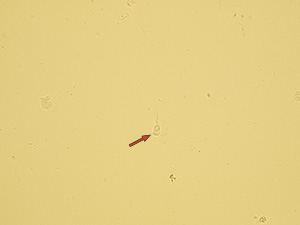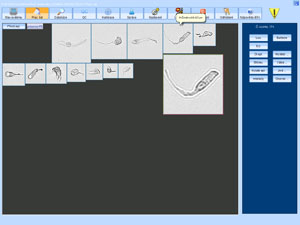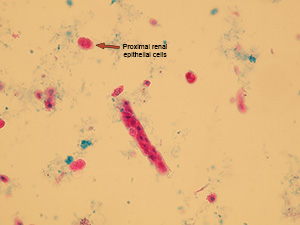Faculty of Medicine, Masaryk University
RNDr. Miroslava Beňovská, Ph.D., Mgr. Ondřej Wiewiorka, MUDr. Jana Tůmová
Epithelial cells
The outside or the inside of the organism surface is covered with epithelial cells. These cells can be found in urine and divided in several groups.
Squamous epithelial cells
These are very large unevenly shaped cells with easily visible nucleus inside. They originate from urethra or vagina. They are very common elements with minimal clinical impact.
Stained sediment
Native sediment
Pictures from FUS-2000 analyzer (DIRUI)
Transitional epithelial cells
These epithelial cells have different shapes and sizes depending on their origin. Round epithelial cells are most common. Their nucleus is in the middle of the cell, they are smaller than squamous epithelial cells and they come from the bladder or proximal segments of urethra in men. If they originate from deeper layers of epithelia or near the renal pelvis, they are smaller and more round.
Limited amount of round transitional epithelial cells may be normal, large amount accounts to urinary tract infection.
Another subcategory is called caudate cells. They come from deep layers of a bladder. The cells with two nuclei are also categorized as transitional epithelial cells. Large number of cells with two nuclei or asymmetric cells can be found in urine from patients with transitional cell (urothelial) carcinomas.
Stained sediment
Native sediment
Pictures from FUS-2000 analyzer (DIRUI)
Renal epithelial cells
These cells have polyedric shape with non-segmented eccentric nucleus. They are the smallest epithelial cells, approximately twice the size of a leukocyte. They don’t absorb water and swell, but keep their polyedric shape. Proximal tubular cells have granulated cytoplasm and sometimes may appear as small or fragmented granular casts. They are clinically significant elements in urine in cases of acute tubular necrosis or viral infection and drug or heavy metal toxicity.
Renal epithelial fragments constitute of several renal cells of collecting duct origin. Their presence in urine is considered to be clinically severe and indicates heavy renal tubular damage.
Stained sediment
Native sediment
Pictures from FUS-2000 analyzer (DIRUI)
Mgr. Ondřej Wiewiorka, MUDr. Jana Tůmová|
KLT, Faculty of Medicine, Masaryk University |
Back to Homepage, accessibility |
| Service Center for E-learning
| Faculty of Informatics, Masaryk University, 2016

























